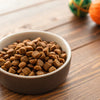Is Freeze-Dried Raw Food Safe for Dogs? Understanding the Benefits and Risks
- Houndsy
Table of Contents
- Introduction
- What Is Freeze-Dried Raw Food?
- Benefits of Freeze-Dried Raw Food for Dogs
- Potential Risks of Freeze-Dried Raw Food
- How to Safely Incorporate Freeze-Dried Raw Food into Your Dog's Diet
- Comparing Freeze-Dried Raw Food to Other Dog Food Options
- Conclusion
Introduction
Imagine your dog eagerly wagging their tail, anticipating mealtime, only to find that their food is not just tasty but also nutritious and safe. As pet owners, we face the delightful yet daunting task of selecting the best diet for our furry companions. With an increasing number of options available, one question that often arises is: Is freeze-dried raw food safe for dogs?
In recent years, the popularity of freeze-dried raw food has surged as pet parents seek less processed alternatives to traditional kibble. This method of preserving raw ingredients offers a unique combination of convenience, nutrition, and taste. However, with this surge in popularity comes the need for careful consideration regarding safety, nutritional balance, and overall health benefits.
In this blog post, we will delve deep into the world of freeze-dried raw food for dogs, exploring its benefits, potential risks, and how it compares to other feeding options. By the end of our discussion, you will have a comprehensive understanding of whether freeze-dried raw food can be a safe and beneficial addition to your dog's diet.
So, let’s reflect on our current feeding routines and explore how we can enhance our pets' mealtime experience together.
What Is Freeze-Dried Raw Food?
Freeze-dried raw food is a type of dog food that retains the nutritional integrity of its raw ingredients through a specialized process called freeze-drying. This technique involves freezing the food and then removing moisture in a vacuum environment, which preserves its original flavor, texture, and nutrients. The result is a lightweight, shelf-stable product that can be rehydrated with water or served dry.
The Freeze-Drying Process
- Initial Freezing: The raw ingredients—such as meats, fruits, and vegetables—are rapidly frozen to prevent the formation of large ice crystals, which can damage the food's cellular structure.
- Sublimation: In a vacuum chamber, the frozen food undergoes sublimation, where ice turns into vapor without becoming liquid. This removes moisture while keeping the food intact.
- Secondary Drying: After sublimation, any remaining water molecules are removed through a process called adsorption, ensuring the food is completely dry and stable for storage.
- Packaging: Finally, the freeze-dried food is sealed in moisture-proof packaging to maintain freshness and prevent spoilage.
This method not only preserves the food's nutritional value but also allows for an extended shelf life, making it a practical choice for busy pet owners.
Benefits of Freeze-Dried Raw Food for Dogs
Nutritional Value
One of the most significant advantages of freeze-dried raw food is its high nutritional content. Because the freeze-drying process retains the integrity of the ingredients, dogs receive a diet rich in proteins, vitamins, and minerals. This nutrient-dense food can support overall health, including:
- Muscle Development: High-quality proteins from meats provide essential amino acids necessary for muscle growth and repair.
- Healthy Coat and Skin: Nutrients like omega fatty acids, often found in freeze-dried raw food, can promote a shiny coat and healthy skin.
- Improved Digestion: Many freeze-dried diets include probiotics, which support gut health and aid digestion.
Convenience and Versatility
Freeze-dried raw food is incredibly convenient for pet owners. It has a long shelf life, is lightweight for travel, and can be served as-is or rehydrated, making it an ideal option for busy lifestyles. This flexibility allows pet parents to mix it with other foods or use it as a meal topper, enhancing variety and appeal during mealtime.
Minimal Processing
Unlike traditional kibble, which undergoes high-temperature cooking processes that can diminish nutritional content, freeze-dried raw food is minimally processed. This means that the natural enzymes, nutrients, and flavors are preserved, giving dogs the benefits of a raw diet without the hassle of handling raw food.
Potential Risks of Freeze-Dried Raw Food
While there are numerous benefits to freeze-dried raw food, it's essential to consider the potential risks associated with its use.
Pathogen Exposure
One of the primary concerns with feeding freeze-dried raw food is the risk of bacterial contamination. Although the freeze-drying process reduces the number of pathogens, it does not eliminate them entirely. Here are some key points to consider:
- Salmonella and E. coli: These harmful bacteria can be present in raw meat and can cause serious illnesses in both dogs and humans. Proper handling, storage, and hygiene practices are critical when dealing with any raw food.
- Pet Owner Safety: Pet owners can also be at risk if they do not handle freeze-dried raw food with proper sanitation. It is crucial to wash hands and surfaces thoroughly after preparing the food to minimize cross-contamination.
Nutritional Balance
Not all freeze-dried raw foods are created equal. Some products may not provide a complete and balanced diet, lacking essential nutrients that dogs need for optimal health. When choosing a freeze-dried raw food, look for:
- AAFCO Approval: Ensure that the product meets the standards set by the Association of American Feed Control Officials (AAFCO) for a complete and balanced diet.
- Ingredient Transparency: Read labels carefully to confirm the quality and sourcing of ingredients.
Cost Considerations
Freeze-dried raw food can be more expensive than traditional kibble due to the intricate processing and high-quality ingredients involved. While the investment may be worthwhile for some, it's important to weigh the benefits against your budget.
How to Safely Incorporate Freeze-Dried Raw Food into Your Dog's Diet
If you decide to introduce freeze-dried raw food into your dog's diet, here are some tips to do so safely:
- Consult Your Veterinarian: Always discuss dietary changes with your vet to ensure that freeze-dried raw food is suitable for your dog's specific needs and health conditions.
- Transition Gradually: Introduce freeze-dried raw food slowly, mixing it with your dog's current food to avoid digestive upset. A gradual transition can help your dog adjust to the new diet.
- Follow Feeding Guidelines: Adhere to the recommended serving sizes on the packaging to ensure your dog receives the appropriate amount of nutrients without overfeeding.
- Hydration: If you choose to rehydrate the freeze-dried food, ensure your dog has access to fresh water at all times.
- Proper Storage: Store freeze-dried raw food in a cool, dry place, and keep it sealed to prevent moisture absorption.
Comparing Freeze-Dried Raw Food to Other Dog Food Options
When considering your dog's diet, it's essential to compare freeze-dried raw food with other options, such as traditional kibble and canned food.
Freeze-Dried Raw Food vs. Kibble
- Processing: Kibble is highly processed, often involving high heat, which can destroy some nutrients. Freeze-dried raw food is minimally processed, retaining more natural nutrients.
- Taste and Palatability: Many dogs find freeze-dried raw food more appealing due to its natural flavors, while kibble can be less enticing.
- Shelf Life: Kibble has a long shelf life, but freeze-dried raw food can last even longer if stored correctly.
Freeze-Dried Raw Food vs. Canned Food
- Nutritional Value: Both freeze-dried raw food and canned food can be nutritious options, but freeze-dried raw food often contains higher protein levels and fewer preservatives.
- Moisture Content: Canned food contains a higher moisture content, which can be beneficial for hydration. Freeze-dried raw food requires rehydration for serving.
- Convenience: Canned food is ready to serve, while freeze-dried raw food requires preparation, making it slightly less convenient for some pet owners.
Conclusion
So, is freeze-dried raw food safe for dogs? While it presents numerous benefits, including high nutritional value, minimal processing, and convenience, potential risks such as pathogen exposure and nutritional imbalances must be considered. Ultimately, the decision to incorporate freeze-dried raw food into your dog's diet should be informed by a thorough understanding of both its advantages and challenges.
As conscientious pet owners, we have the ability to enhance our dog's dining experience with thoughtful choices. By exploring options like the Houndsy Kibble Dispenser, we can simplify mealtime and ensure our dogs receive the nutrition they deserve. If you're interested in elevating your dog's feeding routine, consider checking out our Houndsy Kibble Dispenser for a convenient and stylish solution.
FAQ
Is freeze-dried raw food safe for dogs?
Yes, freeze-dried raw food can be safe for dogs, provided that proper handling and hygiene practices are followed. Always consult your veterinarian and choose high-quality products that meet AAFCO standards.
Can freeze-dried raw food replace my dog's current diet?
Freeze-dried raw food can be a part of your dog's diet, but it should be introduced gradually and balanced with other food sources. Consult your vet for personalized dietary recommendations.
How do I transition my dog to freeze-dried raw food?
Start by mixing a small amount of freeze-dried raw food with your dog's current food and gradually increase the proportion over several days to avoid digestive upset.
What should I look for when choosing freeze-dried raw food?
Look for products that are AAFCO-approved, made with high-quality ingredients, and free from fillers or artificial preservatives. Always check the packaging for feeding guidelines.
How should I store freeze-dried raw food?
Store freeze-dried raw food in a cool, dry place, keeping it sealed in its original packaging to prevent moisture absorption.












